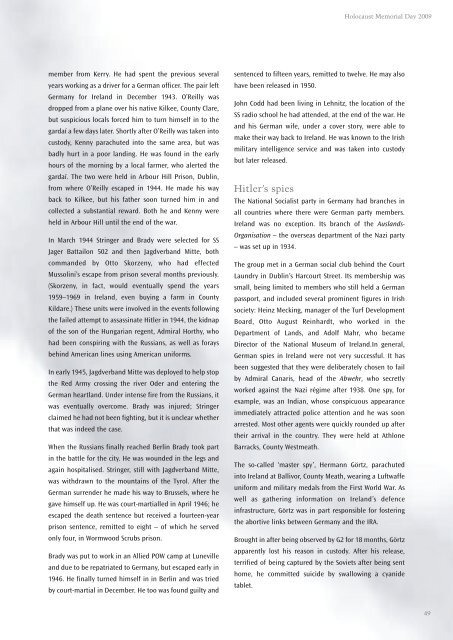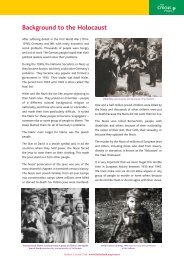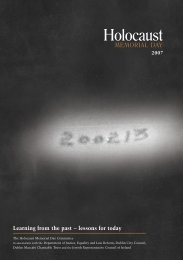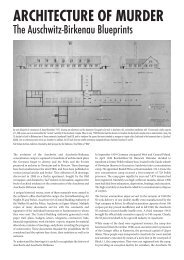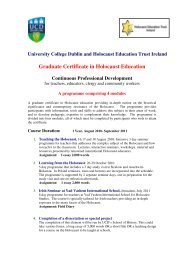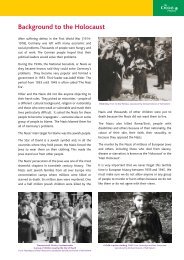Learning from the past ~ lessons for today - Holocaust Education ...
Learning from the past ~ lessons for today - Holocaust Education ...
Learning from the past ~ lessons for today - Holocaust Education ...
Create successful ePaper yourself
Turn your PDF publications into a flip-book with our unique Google optimized e-Paper software.
<strong>Holocaust</strong> Memorial Day 2009<br />
member <strong>from</strong> Kerry. He had spent <strong>the</strong> previous several<br />
years working as a driver <strong>for</strong> a German officer. The pair left<br />
Germany <strong>for</strong> Ireland in December 1943. O’Reilly was<br />
dropped <strong>from</strong> a plane over his native Kilkee, County Clare,<br />
but suspicious locals <strong>for</strong>ced him to turn himself in to <strong>the</strong><br />
gardaí a few days later. Shortly after O’Reilly was taken into<br />
custody, Kenny parachuted into <strong>the</strong> same area, but was<br />
badly hurt in a poor landing. He was found in <strong>the</strong> early<br />
hours of <strong>the</strong> morning by a local farmer, who alerted <strong>the</strong><br />
gardaí. The two were held in Arbour Hill Prison, Dublin,<br />
<strong>from</strong> where O’Reilly escaped in 1944. He made his way<br />
back to Kilkee, but his fa<strong>the</strong>r soon turned him in and<br />
collected a substantial reward. Both he and Kenny were<br />
held in Arbour Hill until <strong>the</strong> end of <strong>the</strong> war.<br />
In March 1944 Stringer and Brady were selected <strong>for</strong> SS<br />
Jager Battailon 502 and <strong>the</strong>n Jagdverband Mitte, both<br />
commanded by Otto Skorzeny, who had effected<br />
Mussolini’s escape <strong>from</strong> prison several months previously.<br />
(Skorzeny, in fact, would eventually spend <strong>the</strong> years<br />
1959–1969 in Ireland, even buying a farm in County<br />
Kildare.) These units were involved in <strong>the</strong> events following<br />
<strong>the</strong> failed attempt to assassinate Hitler in 1944, <strong>the</strong> kidnap<br />
of <strong>the</strong> son of <strong>the</strong> Hungarian regent, Admiral Horthy, who<br />
had been conspiring with <strong>the</strong> Russians, as well as <strong>for</strong>ays<br />
behind American lines using American uni<strong>for</strong>ms.<br />
In early 1945, Jagdverband Mitte was deployed to help stop<br />
<strong>the</strong> Red Army crossing <strong>the</strong> river Oder and entering <strong>the</strong><br />
German heartland. Under intense fire <strong>from</strong> <strong>the</strong> Russians, it<br />
was eventually overcome. Brady was injured; Stringer<br />
claimed he had not been fighting, but it is unclear whe<strong>the</strong>r<br />
that was indeed <strong>the</strong> case.<br />
When <strong>the</strong> Russians finally reached Berlin Brady took part<br />
in <strong>the</strong> battle <strong>for</strong> <strong>the</strong> city. He was wounded in <strong>the</strong> legs and<br />
again hospitalised. Stringer, still with Jagdverband Mitte,<br />
was withdrawn to <strong>the</strong> mountains of <strong>the</strong> Tyrol. After <strong>the</strong><br />
German surrender he made his way to Brussels, where he<br />
gave himself up. He was court-martialled in April 1946; he<br />
escaped <strong>the</strong> death sentence but received a fourteen-year<br />
prison sentence, remitted to eight – of which he served<br />
only four, in Wormwood Scrubs prison.<br />
Brady was put to work in an Allied POW camp at Luneville<br />
and due to be repatriated to Germany, but escaped early in<br />
1946. He finally turned himself in in Berlin and was tried<br />
by court-martial in December. He too was found guilty and<br />
sentenced to fifteen years, remitted to twelve. He may also<br />
have been released in 1950.<br />
John Codd had been living in Lehnitz, <strong>the</strong> location of <strong>the</strong><br />
SS radio school he had attended, at <strong>the</strong> end of <strong>the</strong> war. He<br />
and his German wife, under a cover story, were able to<br />
make <strong>the</strong>ir way back to Ireland. He was known to <strong>the</strong> Irish<br />
military intelligence service and was taken into custody<br />
but later released.<br />
Hitler’s spies<br />
The National Socialist party in Germany had branches in<br />
all countries where <strong>the</strong>re were German party members.<br />
Ireland was no exception. Its branch of <strong>the</strong> Auslands-<br />
Organisation – <strong>the</strong> overseas department of <strong>the</strong> Nazi party<br />
– was set up in 1934.<br />
The group met in a German social club behind <strong>the</strong> Court<br />
Laundry in Dublin’s Harcourt Street. Its membership was<br />
small, being limited to members who still held a German<br />
passport, and included several prominent figures in Irish<br />
society: Heinz Mecking, manager of <strong>the</strong> Turf Development<br />
Board, Otto August Reinhardt, who worked in <strong>the</strong><br />
Department of Lands, and Adolf Mahr, who became<br />
Director of <strong>the</strong> National Museum of Ireland.In general,<br />
German spies in Ireland were not very successful. It has<br />
been suggested that <strong>the</strong>y were deliberately chosen to fail<br />
by Admiral Canaris, head of <strong>the</strong> Abwehr, who secretly<br />
worked against <strong>the</strong> Nazi régime after 1938. One spy, <strong>for</strong><br />
example, was an Indian, whose conspicuous appearance<br />
immediately attracted police attention and he was soon<br />
arrested. Most o<strong>the</strong>r agents were quickly rounded up after<br />
<strong>the</strong>ir arrival in <strong>the</strong> country. They were held at Athlone<br />
Barracks, County Westmeath.<br />
The so-called ‘master spy’, Hermann Görtz, parachuted<br />
into Ireland at Ballivor, County Meath, wearing a Luftwaffe<br />
uni<strong>for</strong>m and military medals <strong>from</strong> <strong>the</strong> First World War. As<br />
well as ga<strong>the</strong>ring in<strong>for</strong>mation on Ireland’s defence<br />
infrastructure, Görtz was in part responsible <strong>for</strong> fostering<br />
<strong>the</strong> abortive links between Germany and <strong>the</strong> IRA.<br />
Brought in after being observed by G2 <strong>for</strong> 18 months, Görtz<br />
apparently lost his reason in custody. After his release,<br />
terrified of being captured by <strong>the</strong> Soviets after being sent<br />
home, he committed suicide by swallowing a cyanide<br />
tablet.<br />
49


